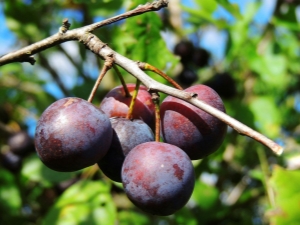Wild plum: description and features of vaccination

Usually in gardens try to grow cultivated plants.Wild varieties, especially if they are prickly and with acidic, inadequate fruits, are planted at best as a protective strip. However, such trees should not be neglected, because with the most minimal care they will give healthy fruits. In addition, they can graft cuttings of the varieties you like and not spend money on seedlings. One of these plants is blackthorn, or wild plum.
Characteristic
Wild plum is the ancestor of all cultivated varieties of plum. Grows in the form of a shrub or tree. Forms impassable thickets on the banks and floodplains of rivers in the steppe and forest-steppe zone, as well as in the mountains of the Caucasus, the Carpathians, on the spurs of the Tien Shan.
Like all wild plants, thorns are hardy and unpretentious. Growing fast. Planted by seed, he gives the first crop at the age of seven. By the age of nine it grows taller than a man’s height, and when grown up it is a three-meter bush or a tree with a spreading hip-top crown.
Blooms profusely, early, even before the leaves bloom. Flowers are very fragrant. Prickly plum is a beautiful honey plant, well pollinated by bees. In August, ripen small dark-purple with a reddish tinge of the fruit. They have a tart, even bitter taste. After the onset of frosts become suitable for use, fresh for almost a month. Thorns fruit annually and abundantly.
With the help of cross-breeding garden plums and thorns were created hybrids. By the names of "parents" they were called shreds. In the gardens there are such sweet fruit varieties such as "dessert turn", "turn sweet", "Renklod thorns". The fruits of this culture have excellent taste, can be kept fresh for about three weeks. They are larger than those of wild plums.
The turn is widely used in cooking: jam, compote is prepared from it. Tart and sour-bitter berries are used to make excellent wine called blackthorn.
Benefit and harm
All parts of the shrub - flowers, berries, bark, roots, have different medicinal properties: they reduce fever, disinfect, relieve inflammation, facilitate the discharge of sputum from the lungs, have a weak anthelmintic effect. They have long been widely used in traditional medicine.
Preparations of thorns flowers are used in the form of infusion or decoction. Gather flowers before they open. To prepare the broth, take two teaspoons of crushed raw materials, pour 250 milliliters of water and bring to a boil over low heat. Take 100 milliliters twice a day. Use means for treatment of the following diseases:
- cough and cold;
- rheumatism;
- atherosclerosis;
- some liver diseases;
- inflammation and rash on the skin wipe with infusion of flowers.
Tart and sour blackthorn berries are very useful for the body.
Gather them in October. For long-term storage, dried in an oven or oven with a slight heat for several days. From the dried berries prepare a decoction, you can add them to compote mixture. Fresh fruit, removing pre-bones, processed in mashed potatoes or juice. The spectrum of action of drugs is diverse:
- berries have a positive effect on the functioning of the stomach and intestines, significantly reduce the likelihood of the development and development of gastritis, stabilize the microflora;
- due to the diuretic action, they promote the elimination of harmful substances and compounds from the body, strengthen the walls of blood vessels, normalize the heartbeat;
- If you eat several plums a day, you can get rid of oral inflammations and unpleasant odors;
The roots are also harvested in the fall. After digging, they are cleaned from the ground, thoroughly washed, dried, crushed and dried at a temperature of 60 degrees. They are used to make a decoction: ten grams of dry chopped root is poured with half a liter of cool water and simmered for 15 minutes. Filter and drink three times a day, 100 milliliters. Apply a medicine from roots at cold and ORVI for decrease in heat and removal of toxins.
The bark is harvested in early spring, before flowering. After collecting it is also washed and dried (drying temperature - 60 degrees). Prepare the medicine as follows: one teaspoon of crushed bark is poured 250 milliliters of water and boiled for 15 minutes with low heat, then filtered. It is better to take three times a day for 100 milliliters. Most often, drugs from the bark treat such diseases as:
- inflammatory processes of the female reproductive system;
- boils, ulcers and other skin lesions.
It should be remembered that before using any medicine based on blackthorn, it is imperative to consult with your doctor. For this there are serious contraindications.
For example, berries and preparations made on their basis cannot be applied to people with high acidity of the stomach, acute ulcers, and especially with the likelihood of gastric bleeding. With high blood pressure is also better to abandon the use of these dosage forms.
Thorn berries are made of tasty preparations.
To make jam on one kilogram of fruit, you need to take 1.5-2 kilograms of sugar. Washed berries are dipped in boiling water (approximately one liter) and blanched over low heat for 15-20 minutes. Then the broth is poured into a separate dish, and the turn turns into a colander and the bones are removed. Add the broth again, then the sugar and mix until it is completely dissolved. Next, cook at low boil for 15 minutes. Hot jam is poured into prepared sterile jars and rolled.
The ratio of berries and sugar in the preparation of jam the other - one to one. Fruits in the same way prepare and wash. Pour them with a small amount of water (to cover only the top) and boil over low heat for about half an hour. After that, the mass is rubbed through a sieve to remove bones. Shift back into the pot, pour the sugar, mix thoroughly. Boil for another half hour, until thickening, constantly stirring so as not to burn. Ready jam laid out in clean jars. You can roll them up or close the plastic covers.
To prepare the compote, washed berries are blanched with a strong boil for five minutes. Throw in a colander, laid out in banks. Add sugar in the ratio of one to one to the broth and boil until it is dissolved. The resulting syrup is poured berries in banks and sterilized for 15-20 minutes. Then roll the covers.
The nucleoli of the thorns seed contains a toxic substance - prussic acid. Preparations without removal of the bones are not subject to long-term storage, as their consumption can lead to serious poisoning of the body.
Roasted kernels on a dry frying pan become harmless. In the form of a hammer they are used as a substitute for natural coffee.
Tincture of wild plum fruit called thorns. To prepare one liter of wine, you will need one kilogram of berries, one liter of water and three hundred grams of sugar. It is better to collect the fruits after the onset of frosts, then they are wicked for two to three days, kneaded a little and filled with water. Put in a warm place for three days. After the bubbles appear on the surface, filter the mixture and remove the bones. Add sugar, mix thoroughly, bottled, corked and stored for storage in a cool room.
Thorns can be pickled, they are not inferior to canned olives.
Graft
Sweet garden plums are often propagated by grafting. Before you start, you need to remember some important points:
- It is best to vaccinate in the spring with the start of active sap flow or early summer, but not in the fall. Autumn vaccine does not take root.
- It is important to remember about the compatibility of rocks. The best survival rate will be if to instill the drain in the drain.
- Cuttings are cut from healthy trees, the stock must also be healthy.
- The operation is carried out with a clean, sharp instrument and fast, confident movements.
- The cut is immediately wrapped with tape or special tape for inoculations, tightening the graft and stock together so that they grow together faster.
- All voids and the upper cut of the cutting are carefully covered with garden pitch so that the vaccine does not die from drying out.
- You can wear a paper bag on the stalk to protect the growing shoots from the bright sun.
A wild thorny shrub with thorny branches is a hardy and cold-resistant plant, cuttings on it will receive good nutrition and strong immunity.
Therefore, a good solution would be to instill a plum on the turn.
Vaccination can be done in several ways:
- In the split. It is used when the stock is much thicker than a scion. On the site of the future vaccinations make a smooth, without chipping cut. Then split to a depth of about five centimeters. In the resulting split insert the stalk, gently wrapped with tape and smeared with garden pitch.
- Copulation, or graft cutting. The most common method, it is used with an equal thickness of the cutting and stock. Make oblique cuts of the same size, align them, press tightly and fix with tape. Also smear pitch.
- Budding, vaccination kidney. Usually it is made in the summer, when the leaves are completely bloomed. From the variety that they want to grow, cut a leaf with a kidney and a small piece of bark (a very thin layer). A cross-cut is made on the wild-stock, the bark on which is bent slightly to the sides. A sheet with a kidney is inserted into the incision, the bark is bent back and tightly wrapped with film. If the graft takes root safely, a young shoot sprouts in the fall.
The turn is not only a good stock, but can also be a pollinator for garden plums. Thanks to this neighborhood, the yield is significantly increased.
To learn how to plant a wild plum, see the next video.
Tips and tricks
Growing thorns in the garden - it is quite simple. It has high frost resistance and drought resistance, undemanding to the composition of the soil. Prefers lighted, sunny places.
To get your own seedlings, you can sow seeds in the late autumn. Also, the turn, according to the description of the variety, is well propagated by root suckers.
If you plant a wild sladkoplodnaya plum around the perimeter of the garden as a hedge, it will serve as a reliable protection of planting from animals, even hares will not pass through thorny thickets. In addition, the turn is the raw material for medicines for many diseases and tasty preparations for the winter.
On the beneficial properties of wild plums, see below.

































